Transcranial Magnetic Stimulation (TMS) Report Analysis
VerifiedAdded on 2020/04/15
|8
|1750
|333
Report
AI Summary
This report provides a comprehensive overview of Transcranial Magnetic Stimulation (TMS) and its applications in the field of neuroscience. It begins by introducing TMS as a non-invasive procedure used to treat depression when other treatments fail, explaining its mechanism of action involving magnetic pulses to stimulate nerve cells. The report delves into the advantages and disadvantages of TMS, highlighting its ability to target specific brain regions while acknowledging the lack of complete understanding of its mechanisms. An empirical example from Stewart et al. (2001) is used to illustrate the impact of TMS on object recognition. The report also discusses various applications of TMS in cognitive neuroscience, such as measuring cortical excitability and understanding ongoing cortical activity. The report concludes by emphasizing the potential of TMS, while also noting the need for further research to fully understand its mechanisms and ensure patient safety.
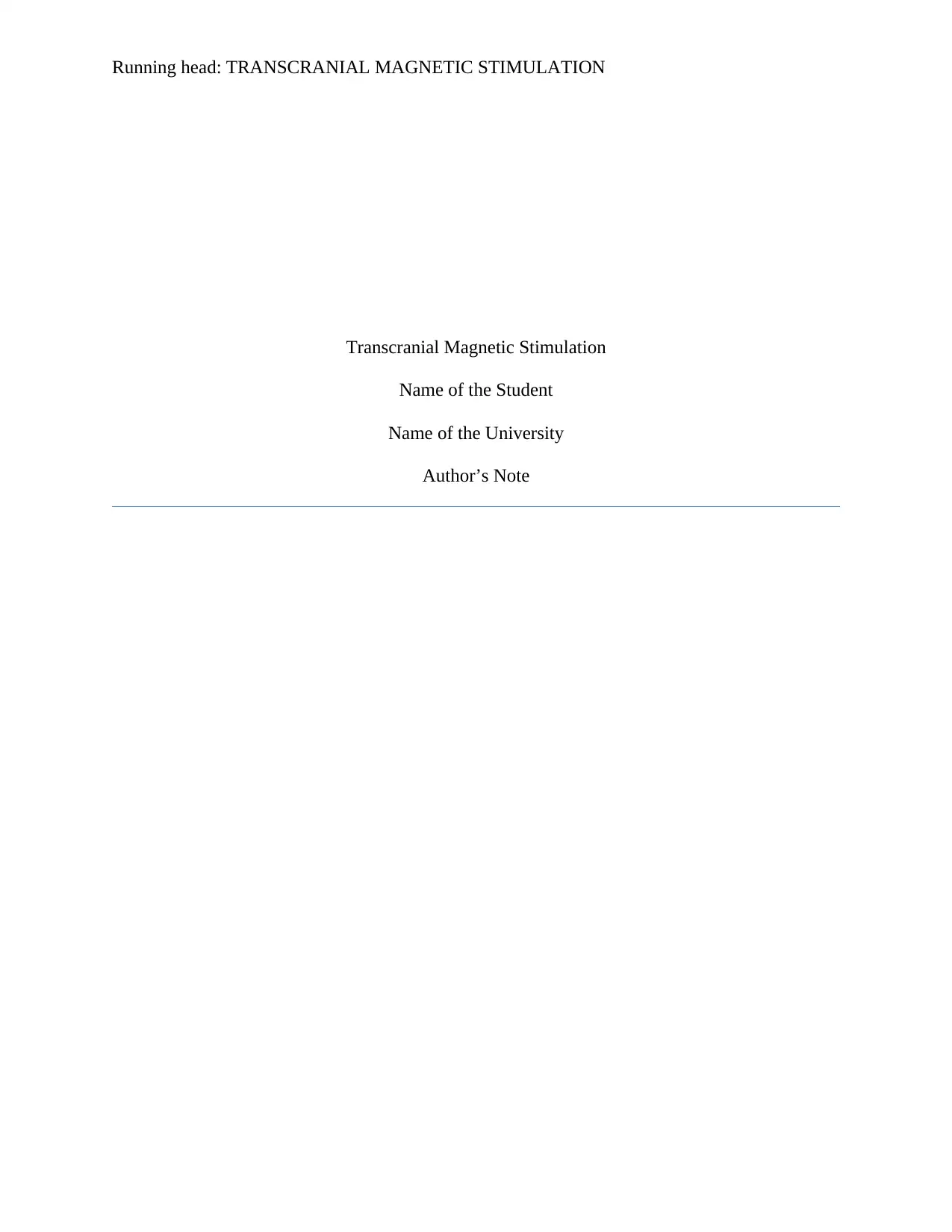
Running head: TRANSCRANIAL MAGNETIC STIMULATION
Transcranial Magnetic Stimulation
Name of the Student
Name of the University
Author’s Note
Transcranial Magnetic Stimulation
Name of the Student
Name of the University
Author’s Note
Paraphrase This Document
Need a fresh take? Get an instant paraphrase of this document with our AI Paraphraser
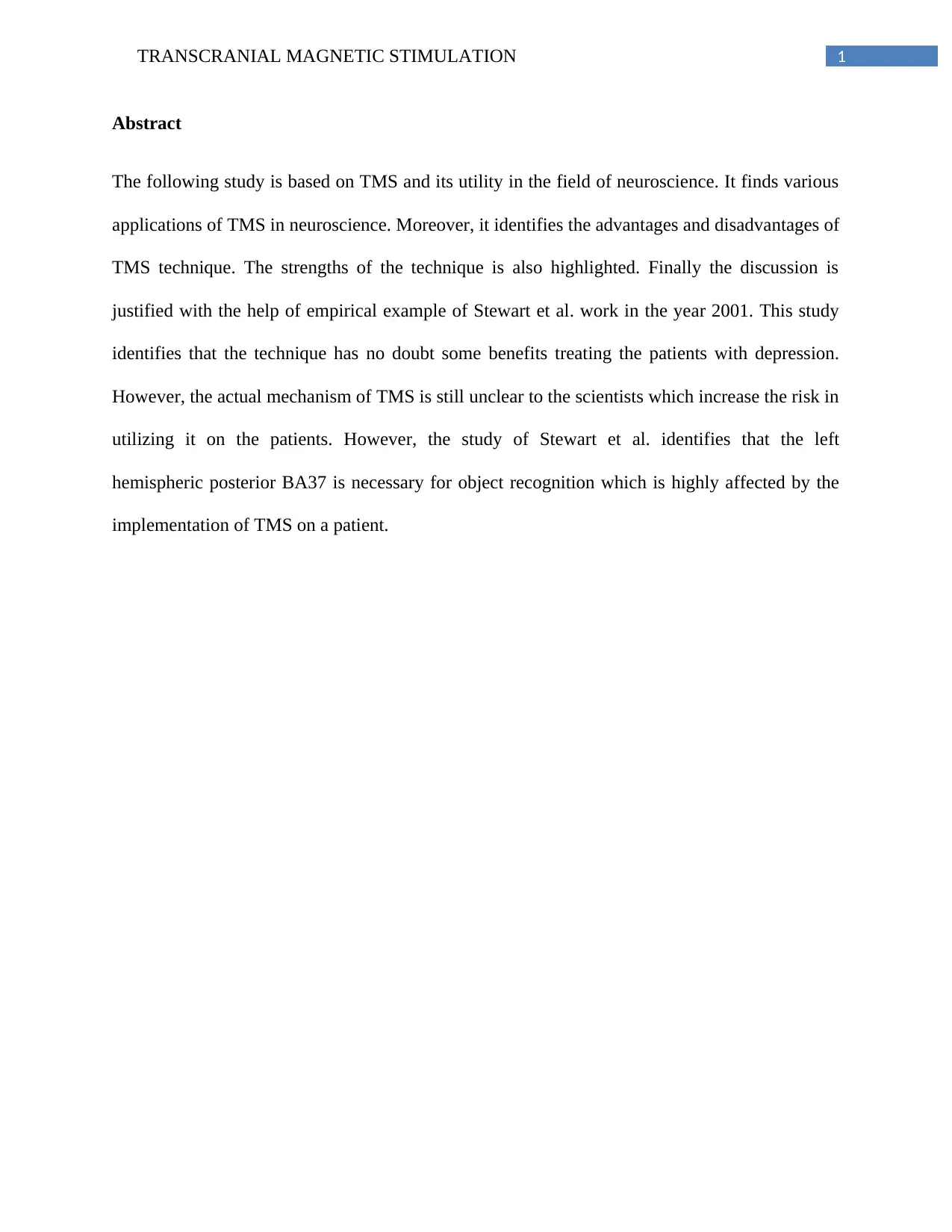
1TRANSCRANIAL MAGNETIC STIMULATION
Abstract
The following study is based on TMS and its utility in the field of neuroscience. It finds various
applications of TMS in neuroscience. Moreover, it identifies the advantages and disadvantages of
TMS technique. The strengths of the technique is also highlighted. Finally the discussion is
justified with the help of empirical example of Stewart et al. work in the year 2001. This study
identifies that the technique has no doubt some benefits treating the patients with depression.
However, the actual mechanism of TMS is still unclear to the scientists which increase the risk in
utilizing it on the patients. However, the study of Stewart et al. identifies that the left
hemispheric posterior BA37 is necessary for object recognition which is highly affected by the
implementation of TMS on a patient.
Abstract
The following study is based on TMS and its utility in the field of neuroscience. It finds various
applications of TMS in neuroscience. Moreover, it identifies the advantages and disadvantages of
TMS technique. The strengths of the technique is also highlighted. Finally the discussion is
justified with the help of empirical example of Stewart et al. work in the year 2001. This study
identifies that the technique has no doubt some benefits treating the patients with depression.
However, the actual mechanism of TMS is still unclear to the scientists which increase the risk in
utilizing it on the patients. However, the study of Stewart et al. identifies that the left
hemispheric posterior BA37 is necessary for object recognition which is highly affected by the
implementation of TMS on a patient.
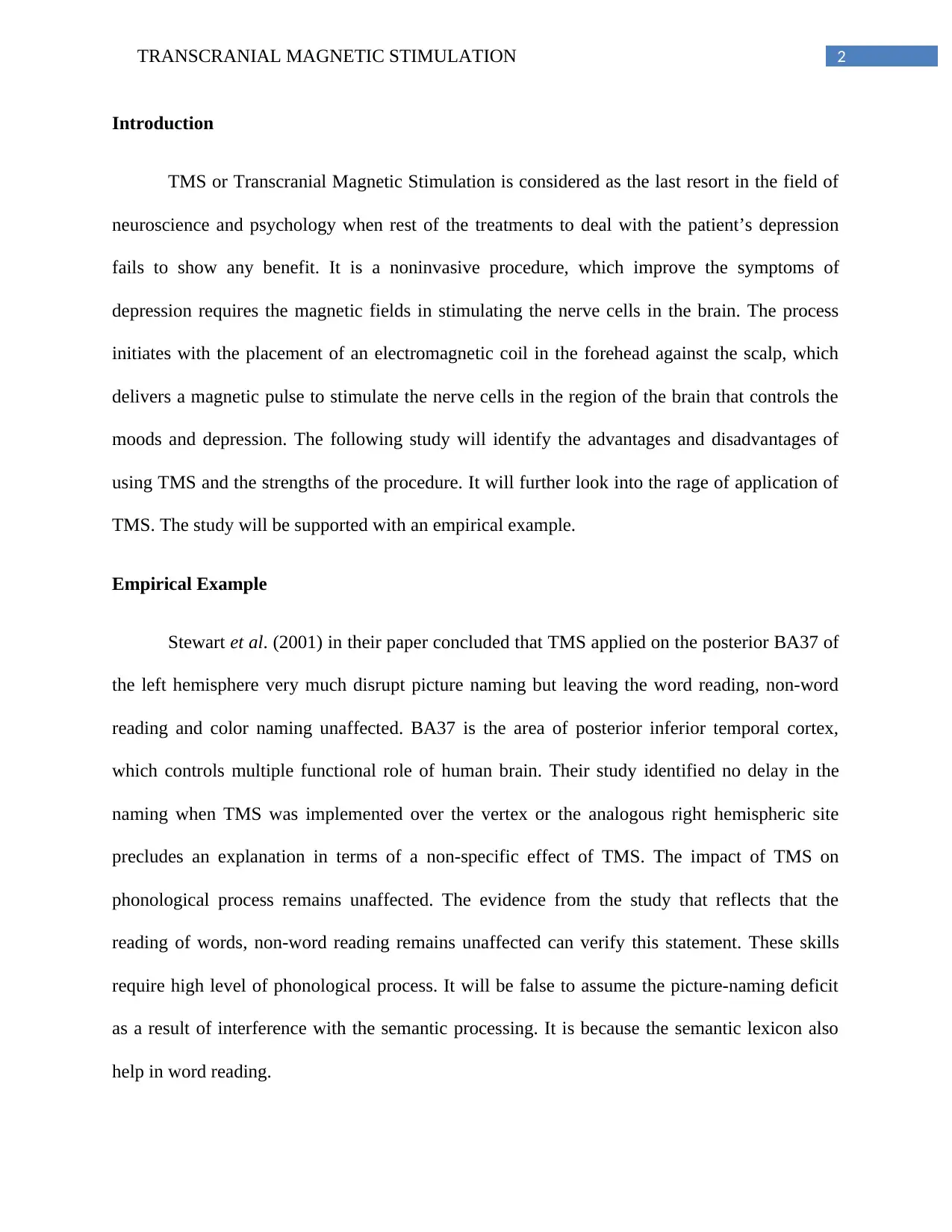
2TRANSCRANIAL MAGNETIC STIMULATION
Introduction
TMS or Transcranial Magnetic Stimulation is considered as the last resort in the field of
neuroscience and psychology when rest of the treatments to deal with the patient’s depression
fails to show any benefit. It is a noninvasive procedure, which improve the symptoms of
depression requires the magnetic fields in stimulating the nerve cells in the brain. The process
initiates with the placement of an electromagnetic coil in the forehead against the scalp, which
delivers a magnetic pulse to stimulate the nerve cells in the region of the brain that controls the
moods and depression. The following study will identify the advantages and disadvantages of
using TMS and the strengths of the procedure. It will further look into the rage of application of
TMS. The study will be supported with an empirical example.
Empirical Example
Stewart et al. (2001) in their paper concluded that TMS applied on the posterior BA37 of
the left hemisphere very much disrupt picture naming but leaving the word reading, non-word
reading and color naming unaffected. BA37 is the area of posterior inferior temporal cortex,
which controls multiple functional role of human brain. Their study identified no delay in the
naming when TMS was implemented over the vertex or the analogous right hemispheric site
precludes an explanation in terms of a non-specific effect of TMS. The impact of TMS on
phonological process remains unaffected. The evidence from the study that reflects that the
reading of words, non-word reading remains unaffected can verify this statement. These skills
require high level of phonological process. It will be false to assume the picture-naming deficit
as a result of interference with the semantic processing. It is because the semantic lexicon also
help in word reading.
Introduction
TMS or Transcranial Magnetic Stimulation is considered as the last resort in the field of
neuroscience and psychology when rest of the treatments to deal with the patient’s depression
fails to show any benefit. It is a noninvasive procedure, which improve the symptoms of
depression requires the magnetic fields in stimulating the nerve cells in the brain. The process
initiates with the placement of an electromagnetic coil in the forehead against the scalp, which
delivers a magnetic pulse to stimulate the nerve cells in the region of the brain that controls the
moods and depression. The following study will identify the advantages and disadvantages of
using TMS and the strengths of the procedure. It will further look into the rage of application of
TMS. The study will be supported with an empirical example.
Empirical Example
Stewart et al. (2001) in their paper concluded that TMS applied on the posterior BA37 of
the left hemisphere very much disrupt picture naming but leaving the word reading, non-word
reading and color naming unaffected. BA37 is the area of posterior inferior temporal cortex,
which controls multiple functional role of human brain. Their study identified no delay in the
naming when TMS was implemented over the vertex or the analogous right hemispheric site
precludes an explanation in terms of a non-specific effect of TMS. The impact of TMS on
phonological process remains unaffected. The evidence from the study that reflects that the
reading of words, non-word reading remains unaffected can verify this statement. These skills
require high level of phonological process. It will be false to assume the picture-naming deficit
as a result of interference with the semantic processing. It is because the semantic lexicon also
help in word reading.
⊘ This is a preview!⊘
Do you want full access?
Subscribe today to unlock all pages.

Trusted by 1+ million students worldwide
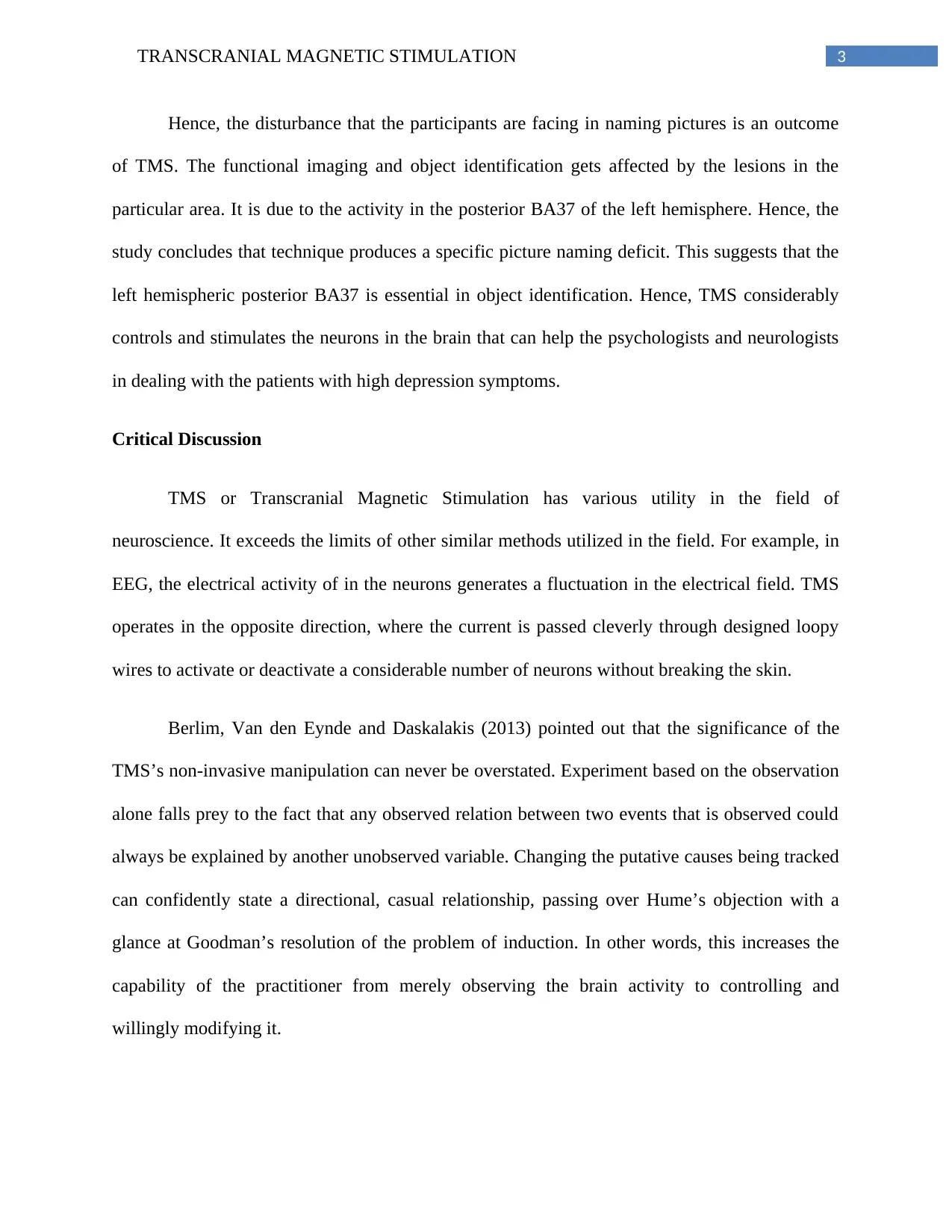
3TRANSCRANIAL MAGNETIC STIMULATION
Hence, the disturbance that the participants are facing in naming pictures is an outcome
of TMS. The functional imaging and object identification gets affected by the lesions in the
particular area. It is due to the activity in the posterior BA37 of the left hemisphere. Hence, the
study concludes that technique produces a specific picture naming deficit. This suggests that the
left hemispheric posterior BA37 is essential in object identification. Hence, TMS considerably
controls and stimulates the neurons in the brain that can help the psychologists and neurologists
in dealing with the patients with high depression symptoms.
Critical Discussion
TMS or Transcranial Magnetic Stimulation has various utility in the field of
neuroscience. It exceeds the limits of other similar methods utilized in the field. For example, in
EEG, the electrical activity of in the neurons generates a fluctuation in the electrical field. TMS
operates in the opposite direction, where the current is passed cleverly through designed loopy
wires to activate or deactivate a considerable number of neurons without breaking the skin.
Berlim, Van den Eynde and Daskalakis (2013) pointed out that the significance of the
TMS’s non-invasive manipulation can never be overstated. Experiment based on the observation
alone falls prey to the fact that any observed relation between two events that is observed could
always be explained by another unobserved variable. Changing the putative causes being tracked
can confidently state a directional, casual relationship, passing over Hume’s objection with a
glance at Goodman’s resolution of the problem of induction. In other words, this increases the
capability of the practitioner from merely observing the brain activity to controlling and
willingly modifying it.
Hence, the disturbance that the participants are facing in naming pictures is an outcome
of TMS. The functional imaging and object identification gets affected by the lesions in the
particular area. It is due to the activity in the posterior BA37 of the left hemisphere. Hence, the
study concludes that technique produces a specific picture naming deficit. This suggests that the
left hemispheric posterior BA37 is essential in object identification. Hence, TMS considerably
controls and stimulates the neurons in the brain that can help the psychologists and neurologists
in dealing with the patients with high depression symptoms.
Critical Discussion
TMS or Transcranial Magnetic Stimulation has various utility in the field of
neuroscience. It exceeds the limits of other similar methods utilized in the field. For example, in
EEG, the electrical activity of in the neurons generates a fluctuation in the electrical field. TMS
operates in the opposite direction, where the current is passed cleverly through designed loopy
wires to activate or deactivate a considerable number of neurons without breaking the skin.
Berlim, Van den Eynde and Daskalakis (2013) pointed out that the significance of the
TMS’s non-invasive manipulation can never be overstated. Experiment based on the observation
alone falls prey to the fact that any observed relation between two events that is observed could
always be explained by another unobserved variable. Changing the putative causes being tracked
can confidently state a directional, casual relationship, passing over Hume’s objection with a
glance at Goodman’s resolution of the problem of induction. In other words, this increases the
capability of the practitioner from merely observing the brain activity to controlling and
willingly modifying it.
Paraphrase This Document
Need a fresh take? Get an instant paraphrase of this document with our AI Paraphraser
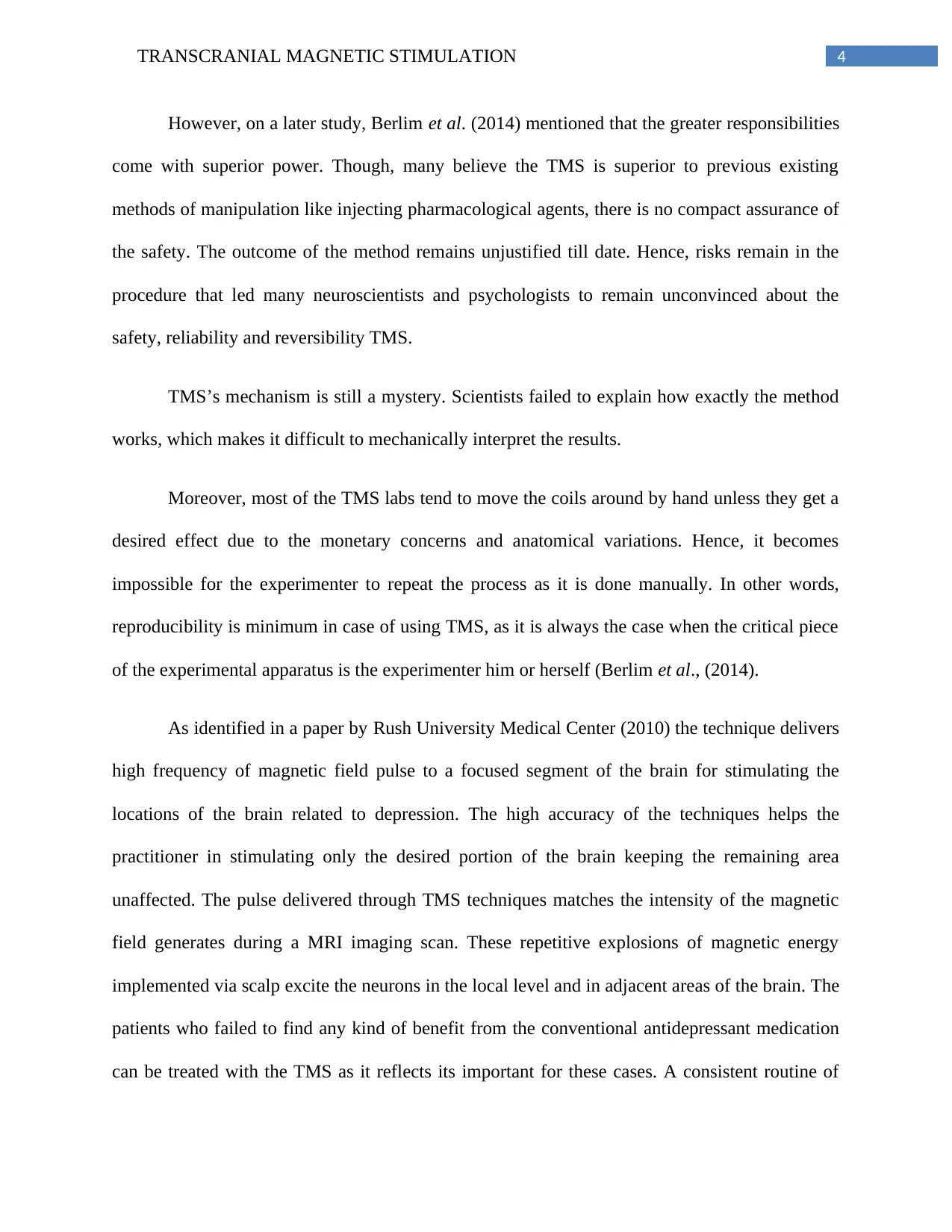
4TRANSCRANIAL MAGNETIC STIMULATION
However, on a later study, Berlim et al. (2014) mentioned that the greater responsibilities
come with superior power. Though, many believe the TMS is superior to previous existing
methods of manipulation like injecting pharmacological agents, there is no compact assurance of
the safety. The outcome of the method remains unjustified till date. Hence, risks remain in the
procedure that led many neuroscientists and psychologists to remain unconvinced about the
safety, reliability and reversibility TMS.
TMS’s mechanism is still a mystery. Scientists failed to explain how exactly the method
works, which makes it difficult to mechanically interpret the results.
Moreover, most of the TMS labs tend to move the coils around by hand unless they get a
desired effect due to the monetary concerns and anatomical variations. Hence, it becomes
impossible for the experimenter to repeat the process as it is done manually. In other words,
reproducibility is minimum in case of using TMS, as it is always the case when the critical piece
of the experimental apparatus is the experimenter him or herself (Berlim et al., (2014).
As identified in a paper by Rush University Medical Center (2010) the technique delivers
high frequency of magnetic field pulse to a focused segment of the brain for stimulating the
locations of the brain related to depression. The high accuracy of the techniques helps the
practitioner in stimulating only the desired portion of the brain keeping the remaining area
unaffected. The pulse delivered through TMS techniques matches the intensity of the magnetic
field generates during a MRI imaging scan. These repetitive explosions of magnetic energy
implemented via scalp excite the neurons in the local level and in adjacent areas of the brain. The
patients who failed to find any kind of benefit from the conventional antidepressant medication
can be treated with the TMS as it reflects its important for these cases. A consistent routine of
However, on a later study, Berlim et al. (2014) mentioned that the greater responsibilities
come with superior power. Though, many believe the TMS is superior to previous existing
methods of manipulation like injecting pharmacological agents, there is no compact assurance of
the safety. The outcome of the method remains unjustified till date. Hence, risks remain in the
procedure that led many neuroscientists and psychologists to remain unconvinced about the
safety, reliability and reversibility TMS.
TMS’s mechanism is still a mystery. Scientists failed to explain how exactly the method
works, which makes it difficult to mechanically interpret the results.
Moreover, most of the TMS labs tend to move the coils around by hand unless they get a
desired effect due to the monetary concerns and anatomical variations. Hence, it becomes
impossible for the experimenter to repeat the process as it is done manually. In other words,
reproducibility is minimum in case of using TMS, as it is always the case when the critical piece
of the experimental apparatus is the experimenter him or herself (Berlim et al., (2014).
As identified in a paper by Rush University Medical Center (2010) the technique delivers
high frequency of magnetic field pulse to a focused segment of the brain for stimulating the
locations of the brain related to depression. The high accuracy of the techniques helps the
practitioner in stimulating only the desired portion of the brain keeping the remaining area
unaffected. The pulse delivered through TMS techniques matches the intensity of the magnetic
field generates during a MRI imaging scan. These repetitive explosions of magnetic energy
implemented via scalp excite the neurons in the local level and in adjacent areas of the brain. The
patients who failed to find any kind of benefit from the conventional antidepressant medication
can be treated with the TMS as it reflects its important for these cases. A consistent routine of

5TRANSCRANIAL MAGNETIC STIMULATION
antidepressant medication later to the TMS implementation can help maintaining the benefits in
most of the patients. The utility of the technique is further spotted by FDA and has approved the
device. The process does not require any anesthesia or sedation like other techniques and the
patient being treated with TMS remains awake and alert during the procedure being
implemented.
The method has helped the experts in understanding the function of the pathological
human brain. They have identified various applications of TMS in the field of cognitive
neuroscience. They are as follows.
Applying TMS over the primary cortices helps to measure the response to single-pulse.
This helps in examining the cortical excitability. The evoked responses can be dependent
variable such as motor phosphene intensity for visual cortex, potential for motor cortex or TMS
intensity threshold essential to draw out those responses.
It can further help in behavioral, cognitive or even brain image testing. An administration
of ten to fifteen minutes of repetitive low frequency of TMS before and after the test helps in
identifying the cognitive state of the participant.
Moreover, short trains of single pulse of high frequency of repetitive TMS can help
understand the ongoing cortical activity and briefly interfere with it. TMS is applied on the
patient while they are engaged in activity or behavioral tasks. The comparison of the
performance reflected by the individual with and without TMS demonstrates that the stimulation
greatly impact on the performance.
Conclusion
antidepressant medication later to the TMS implementation can help maintaining the benefits in
most of the patients. The utility of the technique is further spotted by FDA and has approved the
device. The process does not require any anesthesia or sedation like other techniques and the
patient being treated with TMS remains awake and alert during the procedure being
implemented.
The method has helped the experts in understanding the function of the pathological
human brain. They have identified various applications of TMS in the field of cognitive
neuroscience. They are as follows.
Applying TMS over the primary cortices helps to measure the response to single-pulse.
This helps in examining the cortical excitability. The evoked responses can be dependent
variable such as motor phosphene intensity for visual cortex, potential for motor cortex or TMS
intensity threshold essential to draw out those responses.
It can further help in behavioral, cognitive or even brain image testing. An administration
of ten to fifteen minutes of repetitive low frequency of TMS before and after the test helps in
identifying the cognitive state of the participant.
Moreover, short trains of single pulse of high frequency of repetitive TMS can help
understand the ongoing cortical activity and briefly interfere with it. TMS is applied on the
patient while they are engaged in activity or behavioral tasks. The comparison of the
performance reflected by the individual with and without TMS demonstrates that the stimulation
greatly impact on the performance.
Conclusion
⊘ This is a preview!⊘
Do you want full access?
Subscribe today to unlock all pages.

Trusted by 1+ million students worldwide
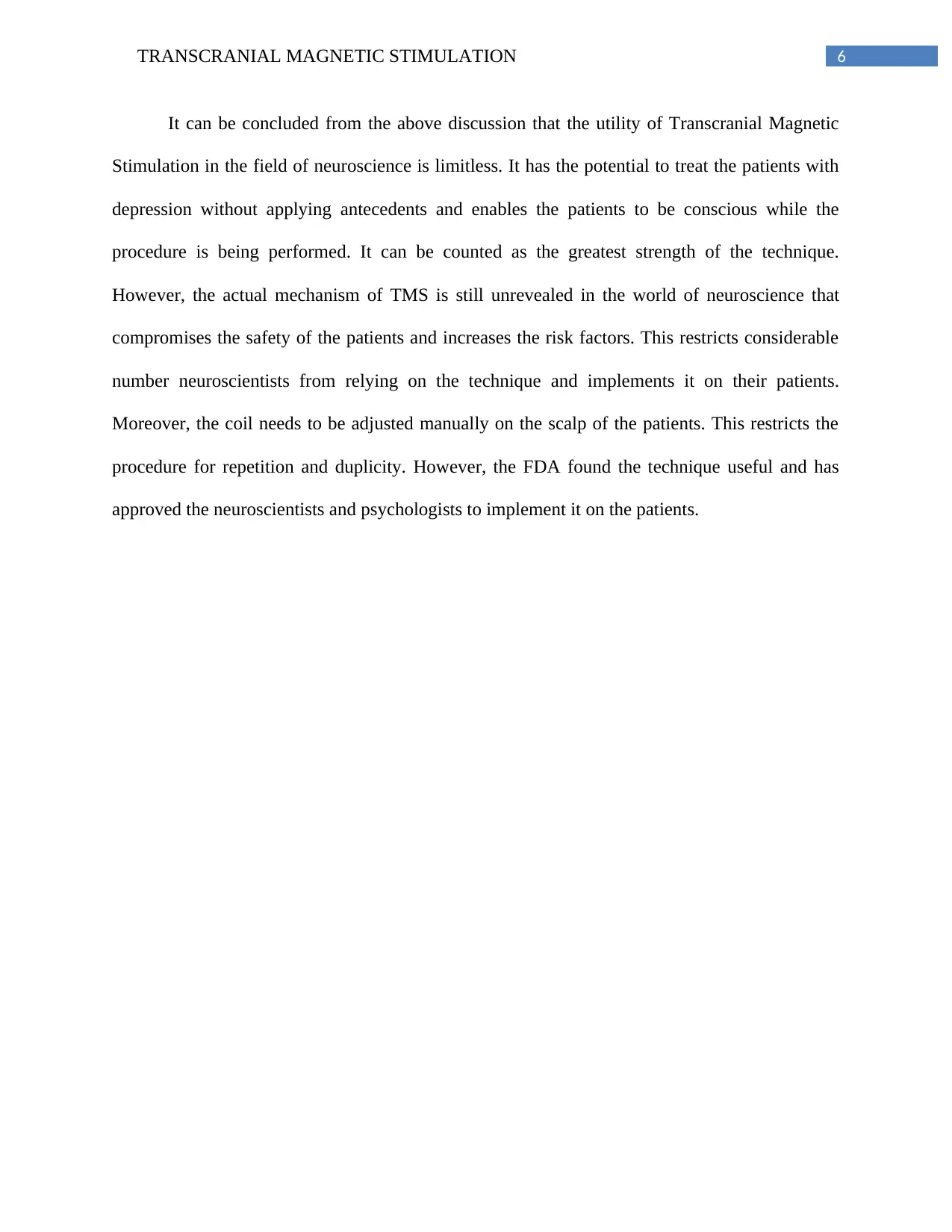
6TRANSCRANIAL MAGNETIC STIMULATION
It can be concluded from the above discussion that the utility of Transcranial Magnetic
Stimulation in the field of neuroscience is limitless. It has the potential to treat the patients with
depression without applying antecedents and enables the patients to be conscious while the
procedure is being performed. It can be counted as the greatest strength of the technique.
However, the actual mechanism of TMS is still unrevealed in the world of neuroscience that
compromises the safety of the patients and increases the risk factors. This restricts considerable
number neuroscientists from relying on the technique and implements it on their patients.
Moreover, the coil needs to be adjusted manually on the scalp of the patients. This restricts the
procedure for repetition and duplicity. However, the FDA found the technique useful and has
approved the neuroscientists and psychologists to implement it on the patients.
It can be concluded from the above discussion that the utility of Transcranial Magnetic
Stimulation in the field of neuroscience is limitless. It has the potential to treat the patients with
depression without applying antecedents and enables the patients to be conscious while the
procedure is being performed. It can be counted as the greatest strength of the technique.
However, the actual mechanism of TMS is still unrevealed in the world of neuroscience that
compromises the safety of the patients and increases the risk factors. This restricts considerable
number neuroscientists from relying on the technique and implements it on their patients.
Moreover, the coil needs to be adjusted manually on the scalp of the patients. This restricts the
procedure for repetition and duplicity. However, the FDA found the technique useful and has
approved the neuroscientists and psychologists to implement it on the patients.
Paraphrase This Document
Need a fresh take? Get an instant paraphrase of this document with our AI Paraphraser
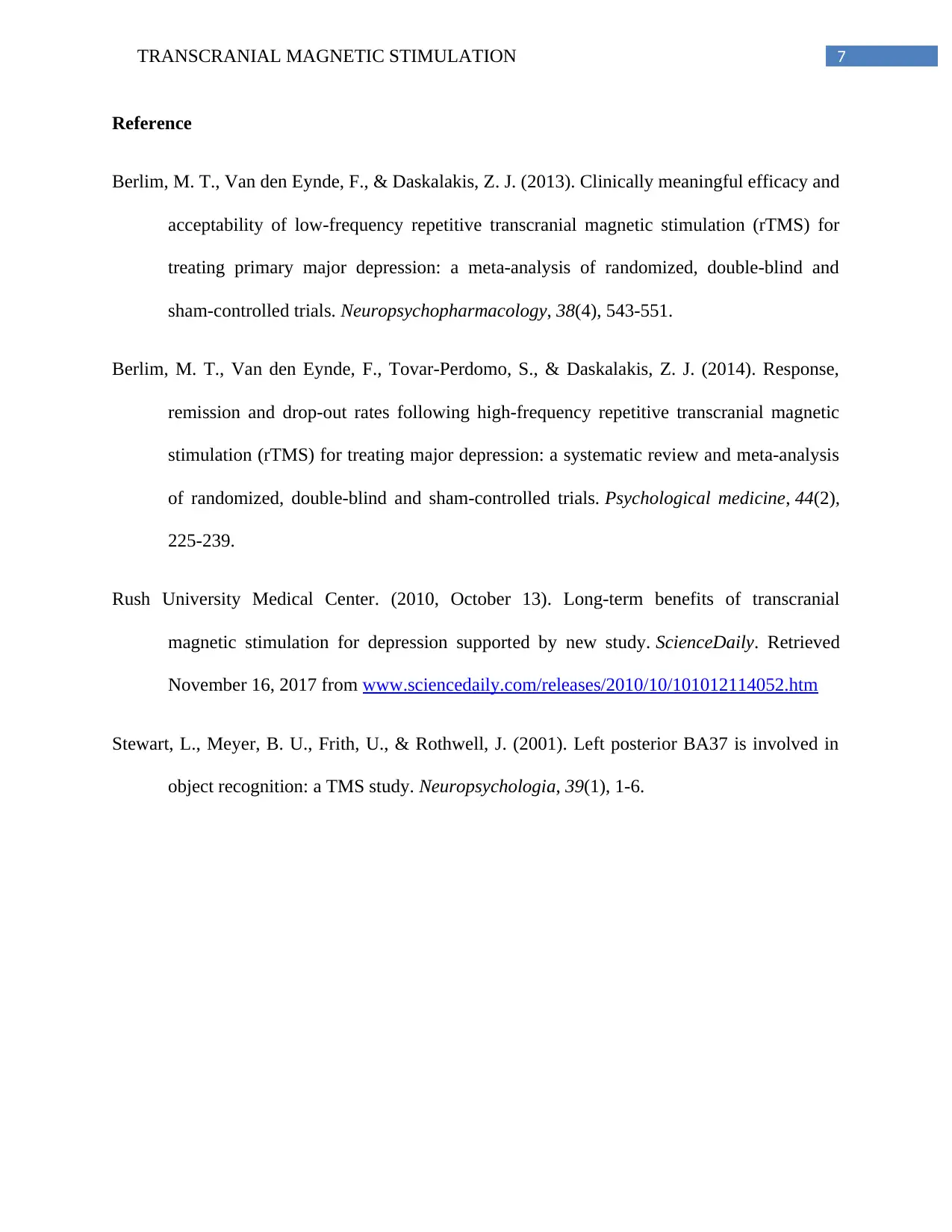
7TRANSCRANIAL MAGNETIC STIMULATION
Reference
Berlim, M. T., Van den Eynde, F., & Daskalakis, Z. J. (2013). Clinically meaningful efficacy and
acceptability of low-frequency repetitive transcranial magnetic stimulation (rTMS) for
treating primary major depression: a meta-analysis of randomized, double-blind and
sham-controlled trials. Neuropsychopharmacology, 38(4), 543-551.
Berlim, M. T., Van den Eynde, F., Tovar-Perdomo, S., & Daskalakis, Z. J. (2014). Response,
remission and drop-out rates following high-frequency repetitive transcranial magnetic
stimulation (rTMS) for treating major depression: a systematic review and meta-analysis
of randomized, double-blind and sham-controlled trials. Psychological medicine, 44(2),
225-239.
Rush University Medical Center. (2010, October 13). Long-term benefits of transcranial
magnetic stimulation for depression supported by new study. ScienceDaily. Retrieved
November 16, 2017 from www.sciencedaily.com/releases/2010/10/101012114052.htm
Stewart, L., Meyer, B. U., Frith, U., & Rothwell, J. (2001). Left posterior BA37 is involved in
object recognition: a TMS study. Neuropsychologia, 39(1), 1-6.
Reference
Berlim, M. T., Van den Eynde, F., & Daskalakis, Z. J. (2013). Clinically meaningful efficacy and
acceptability of low-frequency repetitive transcranial magnetic stimulation (rTMS) for
treating primary major depression: a meta-analysis of randomized, double-blind and
sham-controlled trials. Neuropsychopharmacology, 38(4), 543-551.
Berlim, M. T., Van den Eynde, F., Tovar-Perdomo, S., & Daskalakis, Z. J. (2014). Response,
remission and drop-out rates following high-frequency repetitive transcranial magnetic
stimulation (rTMS) for treating major depression: a systematic review and meta-analysis
of randomized, double-blind and sham-controlled trials. Psychological medicine, 44(2),
225-239.
Rush University Medical Center. (2010, October 13). Long-term benefits of transcranial
magnetic stimulation for depression supported by new study. ScienceDaily. Retrieved
November 16, 2017 from www.sciencedaily.com/releases/2010/10/101012114052.htm
Stewart, L., Meyer, B. U., Frith, U., & Rothwell, J. (2001). Left posterior BA37 is involved in
object recognition: a TMS study. Neuropsychologia, 39(1), 1-6.
1 out of 8
Your All-in-One AI-Powered Toolkit for Academic Success.
+13062052269
info@desklib.com
Available 24*7 on WhatsApp / Email
![[object Object]](/_next/static/media/star-bottom.7253800d.svg)
Unlock your academic potential
Copyright © 2020–2025 A2Z Services. All Rights Reserved. Developed and managed by ZUCOL.